How to Cook a Frozen Lobster Tail
How to Cook a Frozen Lobster Tail: Full Guide from Freezer to Plate

For many home cooks, lobster feels intimidating—especially when it’s frozen. But I always tell people that frozen lobster tails are not only more accessible than live lobster, they’re often easier to cook and just as rewarding. You don’t need a restaurant kitchen or special equipment. You just need to know how to handle them properly.
- Why Frozen Lobster Tail Is Worth Learning to Cook
- Understanding Frozen Lobster Tail: What You’re Really Cooking
- Thawing Lobster Tails Correctly (and What Happens If You Don’t)
- Essential Ingredients and Tools for Cooking Lobster Tail
- Butterflying the Lobster Tail for Even Cooking and Better Presentation
- Boiling Lobster Tail Without Overcooking the Flesh
- Steaming for Delicate Texture and Moisture Control
- Time and Temperature Table for Lobster Tail Cooking Methods
- Baking or Broiling Lobster Tail in the Oven
- Grilling Lobster Tail: Char, Smoke, and Butter-Brush Finish
- Cooking Lobster Tail in the Pressure Cooker
- Can You Microwave Lobster Tail? Yes, But Only Like This
- Sauces That Elevate Lobster Tail Without Overpowering It
- Seasoning and Flavoring Variations
- Serving Lobster Tail Like a Chef: Plating and Pairing Ideas
- Storage and Reheating: What to Do with Leftover Lobster
- FAQ
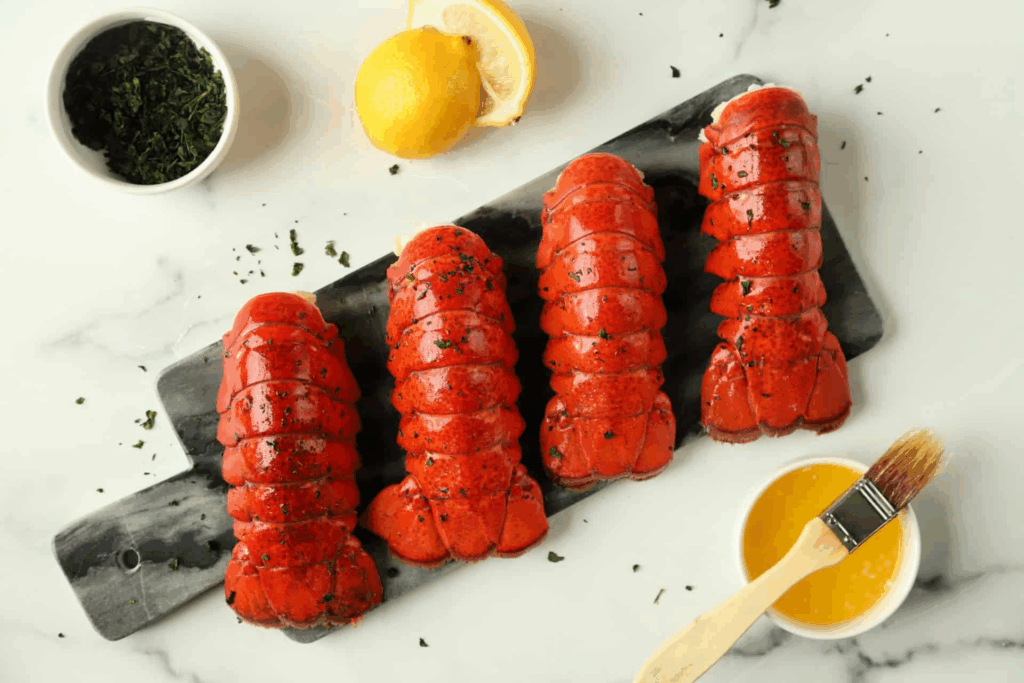
Why Frozen Lobster Tail Is Worth Learning to Cook
I reach for frozen lobster tails when I want to impress guests, elevate a weeknight dinner, or add something luxurious to a holiday spread. When cooked right, the flesh becomes sweet, tender, and rich—without the toughness or fishiness that comes from overcooking or poor handling.
The convenience of frozen over fresh
Fresh lobster tails are hard to find unless you live near the coast or are willing to pay a premium. Frozen tails, on the other hand, are available year-round and are flash-frozen right after harvest to preserve quality. They’re affordable, easy to portion, and store well. That’s why I always keep a few in my freezer.
What makes lobster tail special in a home kitchen
Lobster tail is pure meat—no claws, no body. It cooks faster than a whole lobster and looks beautiful on the plate. It responds well to every major technique: boiling, steaming, baking, grilling, and even pressure cooking. And it doesn’t take much to make it shine—just butter, lemon, and a little confidence.
Understanding Frozen Lobster Tail: What You’re Really Cooking
Not all lobster tails are the same, and knowing what kind you have makes a real difference in how you prepare it. Before you even think about cooking, take a close look at the label and the shell. That tells you what you’re working with.
Cold water vs warm water tails
Cold water lobster tails—usually from Maine, Canada, or Australia—are the best quality. The meat is firmer, whiter, and more flavorful. Warm water tails, typically from the Caribbean or South America, are often cheaper but can be mushy or stringy if overcooked.
I always recommend cold water tails when quality matters. You’ll pay a bit more, but the difference in texture and flavor is worth it. Look for tails with a brown or greenish-brown shell (not gray) and avoid ones with excessive black spots or freezer burn.
How to choose quality frozen tails
I inspect the packaging carefully. I want tails that are frozen individually, not stuck together, and have clear labeling about origin. No added sodium or preservatives is a bonus. If you can see the meat through the shell, it should be white to light pink, not yellow or gray. That’s a sign it was frozen at peak freshness.

Thawing Lobster Tails Correctly (and What Happens If You Don’t)
Thawing is not a throwaway step—it’s the foundation of success. If you cook a lobster tail while it’s still partially frozen, it will cook unevenly and become rubbery or underdone in the center. I always plan ahead and thaw gently.
Fridge thawing vs cold water thaw
If I have time, I thaw tails overnight in the refrigerator, placing them in a bowl or on a plate to catch any drips. This is the safest and most consistent method.
If I’m short on time, I use the cold water method. I place the sealed tails in a bowl of cold water (never warm), changing the water every 30 minutes. Depending on size, they thaw in 1–2 hours.
Never refreeze once thawed. Once soft and pliable, I dry the tails thoroughly with paper towels before preparing them for cooking.
Why microwave defrosting ruins texture
I’ve tested microwave thawing—and I don’t recommend it. Even on low power, it creates hot spots that cook parts of the lobster while leaving others frozen. The result is tough, uneven meat. Microwave defrosting is fast but reckless. If you want tender, restaurant-style lobster, skip it.
Essential Ingredients and Tools for Cooking Lobster Tail
- Frozen lobster tails (5–8 oz each, preferably cold water origin)
- Kosher salt
- Fresh garlic cloves
- Unsalted butter
- Fresh lemon
- Kitchen shears
- Instant-read thermometer
- Baking sheet or steamer basket
- Aluminum foil
- Small saucepan
- Tongs
- Paper towels
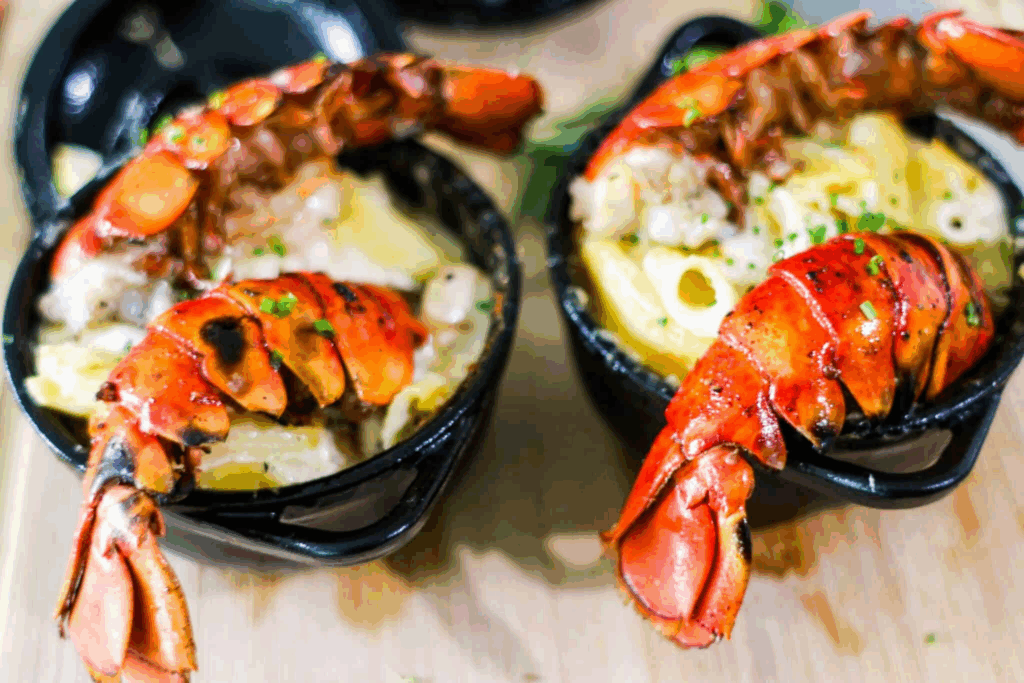
Butterflying the Lobster Tail for Even Cooking and Better Presentation
Butterflying is the technique I use almost every time I cook lobster tails. It’s not just for looks—it ensures even cooking and makes it easier to season and baste the meat. If you’ve ever seen a lobster tail beautifully fanned out on a plate, that’s the result of this method.
How I cut and lift the tail
After the tail is thawed and patted dry, I place it shell-side up on a cutting board. Using sharp kitchen scissors, I cut through the top of the shell—starting from the wide base and moving toward the tail fin—being careful not to cut the meat. I then gently pry the shell apart with my fingers.
Next, I slide my thumb under the meat, lifting it up and out, keeping it attached at the tail end. I rest the meat on top of the shell, so it sits slightly elevated and exposed. This positioning allows for basting, seasoning, and even heat exposure from all directions.
Why this technique matters for beginners
A butterflied tail cooks faster and more evenly. It also allows you to watch the color and texture change as it cooks, which helps avoid overdoing it. For presentation, it gives that restaurant-style wow factor without extra cost or complexity.
Boiling Lobster Tail Without Overcooking the Flesh
Boiling is one of the fastest and easiest methods for cooking lobster tails, but it’s also one of the easiest to mess up. If you leave the meat in the water too long, it will go from juicy to rubbery in minutes. I use this method when I’m cooking multiple tails and need consistent results quickly.
Salted water ratio and timing
I bring a large pot of water to a rapid boil and add 1 tablespoon of kosher salt per quart of water. This mimics ocean water and seasons the meat gently. Once boiling, I lower the thawed tails into the pot and start timing immediately.
A 5–6 oz tail usually takes 3 to 4 minutes; a larger 7–8 oz tail may need 5 to 6 minutes. The shell will turn bright red, and the meat will become opaque and slightly firm to the touch.
Ice bath technique to stop carryover cooking
Once the tails are cooked, I immediately transfer them to an ice water bath to stop the cooking process. This prevents carryover heat from turning perfectly tender lobster into overdone mush. I let them chill for 30–60 seconds, then drain and dry before plating or broiling for a finishing touch.
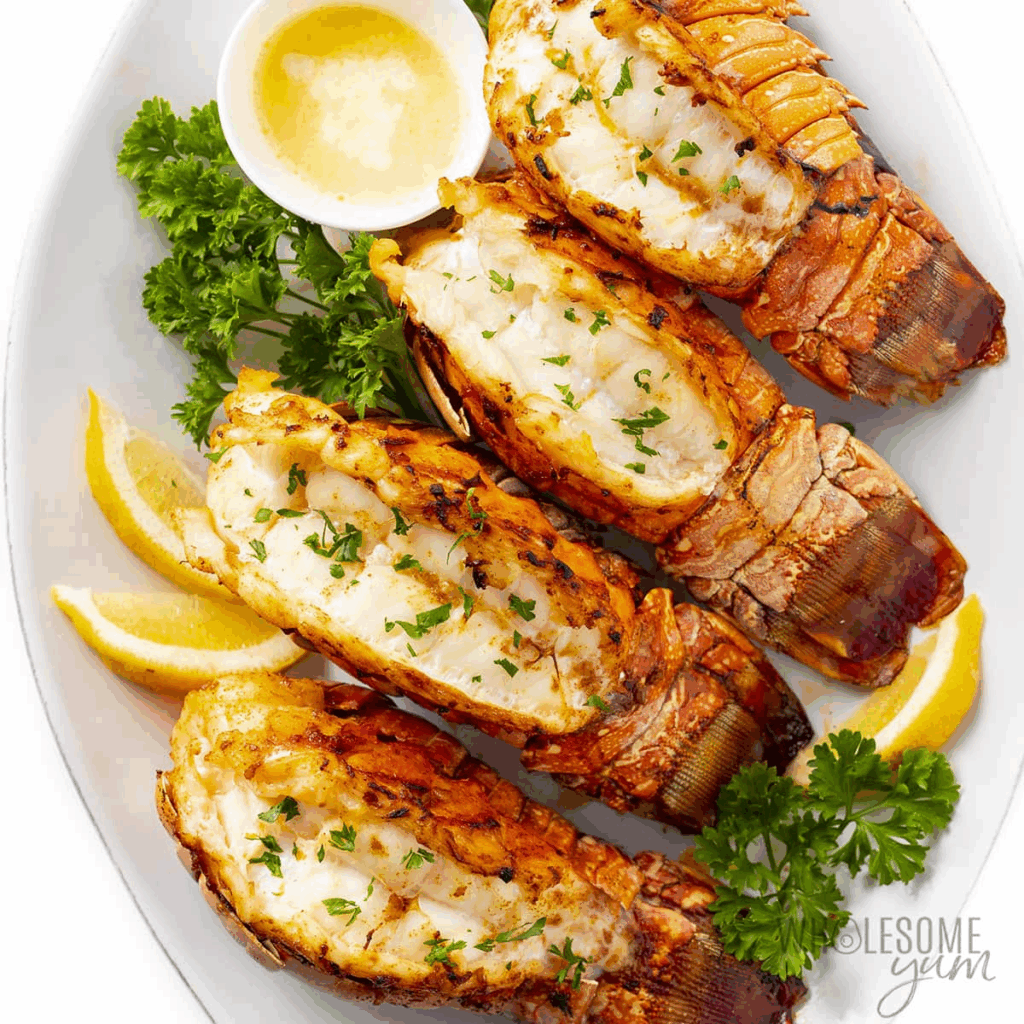
Steaming for Delicate Texture and Moisture Control
Steaming is my favorite method when I want to highlight the natural sweetness of the lobster. It keeps the meat moist and slightly firmer than boiling. It’s also more forgiving if you miss the timer by a minute.
Steamer setup and aromatics
I fill the bottom of a large pot with 1 to 2 inches of water and bring it to a simmer. I add aromatics like lemon slices, garlic, bay leaf, or even a splash of white wine to the water to infuse a light fragrance.
I place the tails on a rack or steamer basket above the water, cover the pot tightly, and steam over medium-high heat. The indirect heat allows for gentle cooking without drying out the surface.
Timing based on tail size
For 5–6 oz tails, I steam for 6 to 7 minutes. Larger tails may need 8 to 9 minutes. I always check the thickest part of the meat with a thermometer—when it hits 135–140°F, I remove them from heat and let them rest. The final internal temperature should reach 140–145°F, never more.
Time and Temperature Table for Lobster Tail Cooking Methods
This is the exact reference I use when cooking lobster tails by size and method. The goal is always tender, juicy meat—not toughness or chew.
| Method | Tail Size | Temp (F / °C) | Time Estimate | Internal Temp | Notes |
| Boiling | 5–6 oz | Boiling (212°F) | 3–4 min | 140°F / 60°C | Use ice bath after cooking |
| Steaming | 5–6 oz | Steam (covered) | 6–7 min | 140°F / 60°C | Infuse water with aromatics |
| Baking | 6–8 oz | 375°F / 190°C | 12–15 min | 140°F / 60°C | Butterflied, on baking sheet |
| Broiling | 6–8 oz | 500°F / 260°C | 6–8 min | 140°F / 60°C | Baste mid-way with butter |
| Pressure Cook | 6–8 oz | Manual High | 1–2 min + release | 140°F / 60°C | Use broth for flavor infusion |
| Microwave | 5–6 oz | 50–60% power | 3–4 min total | 135–140°F | Use cover and moisture |
Baking or Broiling Lobster Tail in the Oven
Baking and broiling are two of the most visually striking ways to cook lobster tail, especially when it’s butterflied. I use these methods when I want a rich, golden top and slightly firmer texture—perfect for dinner parties or romantic dinners at home.
Butter baste vs dry seasoning
When baking, I always brush the exposed meat generously with garlic butter—a mix of melted butter, crushed garlic, lemon zest, and a pinch of paprika. This not only adds flavor but also prevents the meat from drying out during the cook. If I want a spice-forward version, I use a dry rub of salt, cayenne, garlic powder, and smoked paprika—applied just before baking.
Broiling is faster and more intense, so I stay nearby. I position the tails about 5–6 inches from the heating element, skin-side down, and let the broiler caramelize the butter or spices into a light crust.
How I use foil for control
If I’m baking, I often tent the tails with foil for the first 8 minutes to lock in moisture, then uncover them to finish. For broiling, I line the pan with foil to reflect heat upward and prevent mess. I never use parchment under a broiler—it scorches. I always aim for a final internal temperature of 140°F (60°C) with a quick rest.
Grilling Lobster Tail: Char, Smoke, and Butter-Brush Finish
Grilling lobster tail brings out a smoky sweetness that you just can’t replicate in the oven. I love using this method in summer or anytime I want a slightly charred finish without sacrificing tenderness.
How to avoid burning the shell
I preheat the grill to medium-high and oil the grates well. I place the tails meat-side down first for 2–3 minutes to sear the surface, then flip and finish cooking with the shell facing the heat. This prevents charring the meat while using the shell to protect it like a barrier.
If I notice flare-ups or uneven charring, I move the tails to indirect heat and close the lid to finish them gently.
When and how to baste with garlic butter
Once flipped, I baste the lobster continuously with warm garlic butter using a brush or spoon. The butter melts down into the shell and bastes the meat from underneath. I remove the tails from the grill when they hit 135–140°F inside and rest them under foil for a few minutes before serving with more butter on the side.
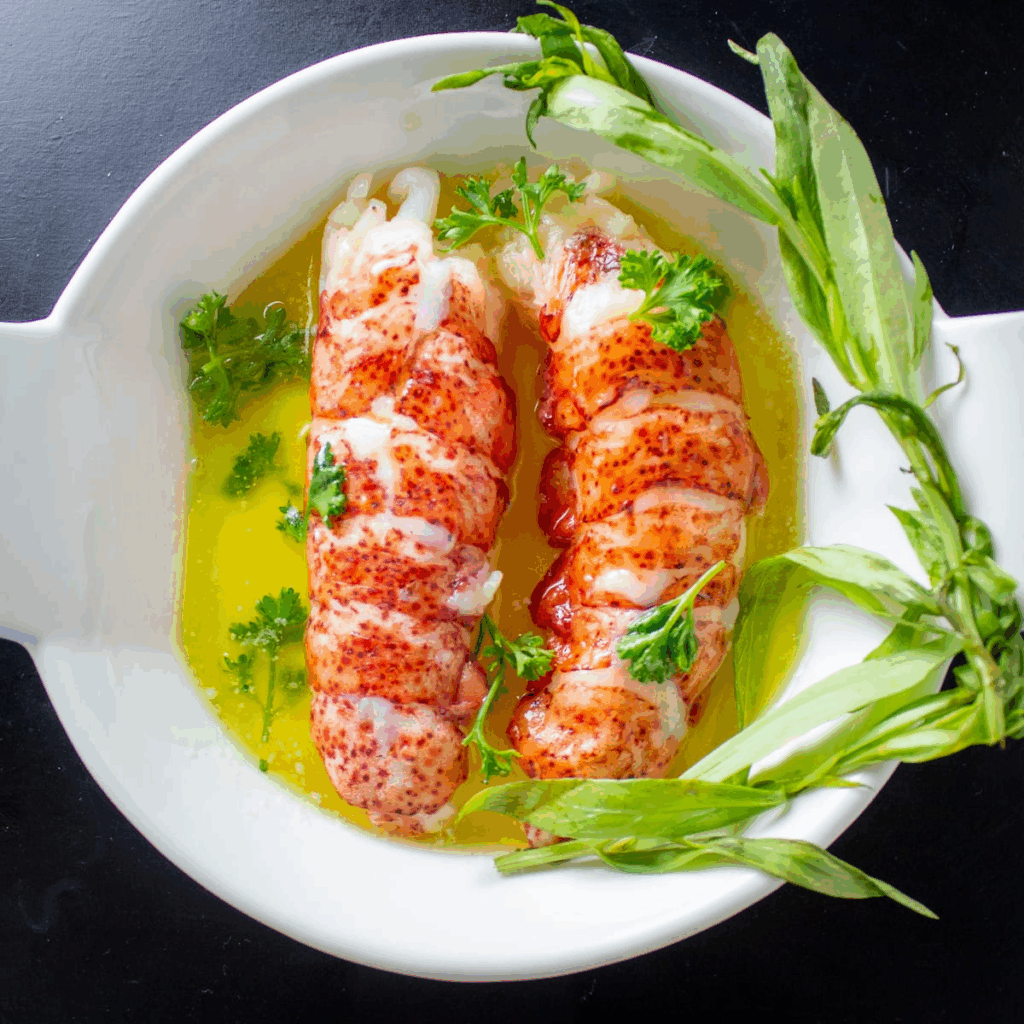
Cooking Lobster Tail in the Pressure Cooker
The pressure cooker might sound like overkill for lobster, but I’ve used it in commercial settings when speed and moisture retention are critical. It’s especially good when I’m serving lobster with sauces or over pasta, where texture doesn’t have to be visually pristine.
Flavor infusion in broth
I place a steamer basket in the pressure cooker and add half a cup of broth, white wine, or even lemon water. I place the butterflied tails on the basket and lock the lid. Using high pressure, I cook for 1 to 2 minutes depending on tail size, then quick-release immediately.
Because the environment is sealed, the flavor stays in the meat. I drizzle any remaining liquid over the tails before serving or use it to make a pan sauce with butter and herbs.
When I choose this method
I reach for the pressure cooker when I need a fast, no-fail way to cook multiple tails evenly—especially for large gatherings, pasta dishes, or surf and turf platters. The texture is tender, the meat is juicy, and with the right aromatics, you barely need additional seasoning.
Can You Microwave Lobster Tail? Yes, But Only Like This
Microwaving lobster tail might seem like culinary heresy, but when done properly, it’s a legitimate method—especially if you’re cooking a single portion or working in a small kitchen. The key is control and moisture.
Moisture retention technique
I always use a microwave-safe dish and pour in 2–3 tablespoons of water, seafood stock, or melted butter. I cover the dish with a microwave-safe lid or loosely with microwave-safe wrap to trap steam. This is essential to prevent the lobster from drying out and turning rubbery.
I place the tail, preferably already butterflied and thawed, in the dish with the meat facing upward.
Covering and power control to avoid rubberiness
I cook on 50–60% power in 30-second intervals, checking in between. A 5–6 oz tail usually takes 3 to 4 minutes total. I use an instant-read thermometer to check for 135°F (57°C), knowing it will rise a few degrees while resting.
Once done, I let it rest under cover for 1–2 minutes, then finish it with a squeeze of lemon and a dab of butter. This method doesn’t give you the same caramelization as other techniques, but it works in a pinch.
Sauces That Elevate Lobster Tail Without Overpowering It
Lobster tail is naturally sweet and delicate, so I avoid drowning it in sauce. The best sauces for lobster complement the flavor, not compete with it. My go-to is garlic butter, but I also experiment with citrus, herbs, and cream depending on the mood or the meal.
Classic garlic butter and citrus-herb
Melted unsalted butter with minced garlic and a pinch of salt is the gold standard. I simmer it gently—not fry—to release the aroma without bitterness. Just before serving, I stir in a little lemon juice and chopped parsley. This simple sauce goes with every cooking method.
For more brightness, I use a mix of lemon zest, white wine, shallots, and olive oil reduced slightly in a pan. A touch of Dijon or tarragon turns it into something elegant and French-inspired. I serve these sauces warm and on the side to let the diner control the richness.
When to add spice, wine, or cream
If I want heat, I add a small amount of red chili flake or cayenne to the butter base. When I want depth, I deglaze the pan with white wine and reduce it with heavy cream and herbs for a velvety texture. These richer sauces work especially well with grilled or baked lobster and are ideal for holiday meals or when pairing with steak.
Seasoning and Flavoring Variations
While lobster doesn’t need heavy seasoning, a thoughtful blend can transform it. I always keep it simple, using seasoning to highlight the meat’s natural profile rather than mask it.
Light seasoning for seafood purists
For purists—and for steamed or boiled tails—I use just kosher salt and a squeeze of lemon. That’s all you need to draw out the lobster’s natural flavor. If I’m steaming over aromatic broth, I don’t season at all before cooking—I finish at the table with butter or vinaigrette.
If I’m poaching in butter, I sometimes add a bay leaf or a whole clove of garlic to the melted butter. That subtle infusion brings elegance without complication.
Spiced rubs and marinades for bold versions
When I want bolder flavor—especially for broiled or grilled tails—I use a dry rub of paprika, chili powder, garlic powder, and a hint of cayenne. I apply it just before cooking to avoid bitterness. For Caribbean-style, I might brush the tail with a mix of lime juice, jerk seasoning, and honey.
I avoid wet marinades for more than 10–15 minutes; acid will toughen the meat if left too long. A light brush just before cooking is all it takes.
Serving Lobster Tail Like a Chef: Plating and Pairing Ideas
Presentation matters—especially with lobster. It’s a premium protein, so I plate it in a way that feels special but not fussy. Clean lines, bright colors, and contrast are what I aim for.
Side dishes that match the delicacy
I serve lobster tail with light, elegant sides. Lemon risotto, garlic mashed potatoes, or sautéed spinach are always winners. For a summer meal, I like chilled couscous salad or roasted asparagus with vinaigrette. I avoid heavy sauces like gravy or cheese—lobster deserves lighter company.
If I’m pairing with starch, I make sure there’s something acidic on the plate—like pickled shallots or a citrus drizzle—to cut through the richness of the butter.
How I plate tails for visual appeal
I arrange the butterflied tail slightly off-center, letting the shell cradle the meat. I add sauce as a swoosh or drizzle around—not on—the tail. A sprig of dill, a lemon twist, or microgreens make the plate look finished. If it’s surf and turf, I plate the lobster first and let the steak complement it, not compete.
Storage and Reheating: What to Do with Leftover Lobster
Leftover lobster tail is a luxury, but it’s fragile. I treat it with the same respect as fresh. Overheating it once is enough to ruin the texture, so storage and reheating must be deliberate.
Chilling and wrapping properly
I wrap cooked lobster tails in parchment or foil and place them in a sealed container. If it’s already out of the shell, I store the meat wrapped in parchment, then place it in a small container with a paper towel underneath to catch condensation.
I keep it refrigerated for up to 2 days, but never more. Freezing is possible, but the texture will suffer unless it’s going into soup or a sauce later. If freezing, I wrap tightly in plastic and foil and use within a month.
Gentle reheating without rubberizing
I reheat lobster gently—never in the microwave on full power. I place the tail in a skillet with a tablespoon of water or butter, cover with a lid, and warm it over low heat for 3–4 minutes. If it’s in pieces, I gently steam or add it at the end of a sauce to warm through without cooking further. I always finish with fresh butter or lemon juice to revive the flavor and texture. Lobster isn’t forgiving—but it can still shine on day two if you’re careful
FAQ
Is cold water lobster really better than warm water?
In my experience—yes. Cold water lobster is sweeter, firmer, and more consistent. Warm water tails can sometimes have a mealy or mushy texture. If you’re serving lobster as the star of the plate, go cold water every time.
Do I need to thaw lobster tails before cooking?
I always recommend thawing lobster tails completely before cooking. It ensures even cooking from edge to center. When tails are cooked from frozen, the outside can overcook while the core stays underdone. I use either overnight fridge thawing or cold water thaw for best results.
Can I cook lobster tails straight from the freezer?
You can, but I don’t advise it unless absolutely necessary. I’ve done it in emergencies by baking them covered at low heat, but the texture is never as tender. Thawing is worth the extra hour—it’s the first step toward great results.
How do I know if my lobster tail is done?
I use an instant-read thermometer and pull the meat at 135–140°F. The flesh should be opaque and white throughout, with a slight firmness but not tough. If it’s translucent or jelly-like, it’s not ready. If it’s curling and rubbery, it’s gone too far.
Should I butterfly every lobster tail?
Yes, especially for oven and grill methods. Butterflying helps with even cooking, seasoning, and plating. I skip it only if I’m boiling multiple tails for salad or pasta where appearance isn’t important.
What’s the fastest method to cook lobster tail?
Boiling is fastest—it takes just 3 to 6 minutes. But my favorite quick method is broiling, which gives beautiful color in under 8 minutes. Just keep an eye on it and use a thermometer.
Can I season lobster before cooking?
I recommend seasoning after butterflying and drying the meat. Salt, pepper, and paprika work great before baking or grilling. I avoid heavy marinades—lobster absorbs flavor quickly and can become overpowered.
What sauce do you recommend for beginners?
Start with garlic butter. Melt butter, add minced garlic, and finish with lemon juice and chopped herbs. It’s foolproof and works with any method. I always serve it on the side or brushed lightly on top after cooking.
Can I use frozen lobster for surf and turf?
Absolutely. I do it often. Just make sure the lobster tail is cooked gently to contrast the seared beef. I serve the tail with garlic butter and the steak with its own sauce so the flavors don’t compete.
How do I keep lobster tail moist in the oven?
I baste with butter and tent with foil during the first half of baking. I never exceed 375°F. Dry heat is the enemy of lobster, so I use indirect heat and finish with sauce for moisture.
What’s the best way to reheat leftover lobster?
I reheat it in a covered pan over low heat with a bit of butter or broth—never the microwave at full power. I also gently steam small pieces and use them in pasta, risotto, or tacos. The key is not to cook it again, just warm it.
Is it safe to eat slightly undercooked lobster?
No. Undercooked shellfish can carry bacteria and parasites. Always check the internal temp—135°F is the lower limit for safety, and I rest the meat until it reaches 140–145°F.
Can I freeze cooked lobster meat?
Yes, but only if I plan to use it in soups, dips, or casseroles. The texture changes when thawed. I wrap it in parchment, then seal it airtight. It keeps for about one month before quality declines.
What side dishes go best with lobster tail?
I serve lobster with light, acidic sides—lemon risotto, arugula salad, grilled vegetables, or couscous. You want balance. Heavy, creamy sides can overpower the delicacy of the lobster.
What’s your personal favorite way to cook lobster tail?
Broiled with garlic butter. I butterfly the tail, baste with butter, broil for 6–7 minutes, and finish with lemon zest and flaky salt. It’s simple, fast, and never fails to impress.



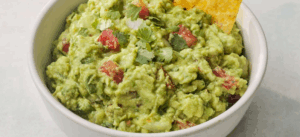
Post Comment